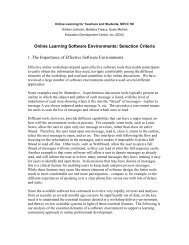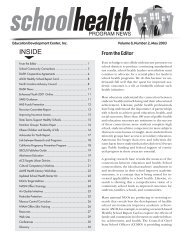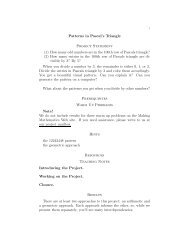It is critical to overcome the digital divide - Education Development ...
It is critical to overcome the digital divide - Education Development ...
It is critical to overcome the digital divide - Education Development ...
You also want an ePaper? Increase the reach of your titles
YUMPU automatically turns print PDFs into web optimized ePapers that Google loves.
life <strong>the</strong>y offer <strong>to</strong> women and minorities. O<strong>the</strong>rs argue that <strong>the</strong> online world <strong>is</strong> reproducing <strong>the</strong>same inequalities as <strong>the</strong> offline world, and losing an opportunity for social change (Cook, 2004).“…A growing body of research <strong>is</strong> producing evidence that traditional off-linehierarchies and biases pers<strong>is</strong>t in CMC [computer mediated communications]. My own work,for example, has shown that males tend <strong>to</strong> dominate in mixed-sex computer-mediatedinteractions, including in academic d<strong>is</strong>cussion forums, through amount of talk, control of<strong>to</strong>pics of d<strong>is</strong>cussion, claims <strong>to</strong> authority, and adversarial behavior such as challenges andput-downs. Such behaviors may cause females <strong>to</strong> limit <strong>the</strong>ir participation, fall silent, orwithdraw from <strong>the</strong> forum al<strong>to</strong>ge<strong>the</strong>r, with concomitant loss of access <strong>to</strong> <strong>the</strong> opportunitiesprovided through <strong>the</strong> online environment.”Susan Herring, Professor of Information Science, Adjunct Professor of Lingu<strong>is</strong>tics,Indiana UniversityLight (2001), in “Rethinking <strong>the</strong> Digital Divide” argues that o<strong>the</strong>r structural inequitiescan’t be ignored, and that those concerned with inequities in <strong>the</strong> field of technology use have <strong>to</strong>also address institutional bias and how society <strong>is</strong> organized (Light, 2001). Schofield andDavidson (2001 - cite) looked at how access <strong>to</strong> technology was used as a form of reward inschools, and thus those who tend <strong>to</strong> get pun<strong>is</strong>hed <strong>the</strong> most, Black and Latino boys (Noguera,2003), were <strong>the</strong> least likely <strong>to</strong> have access <strong>to</strong> technology (Schofield & Davidson, 2001).“Researchers must look more closely at how schools, as social institutions embedded within alarger structure of inequality, are complicit in technological d<strong>is</strong>parities” (Brown-L’Bahy, 2003,p. 16).CULTURE, IDENTITY, AND TECHNOLOGYYouth identity development: a frameworkThe field of youth identity development includes different <strong>the</strong>ories and explanations for<strong>the</strong> way that youth develop <strong>the</strong>ir identities. How youth see <strong>the</strong>mselves as learners, andconsequently as active agents in <strong>the</strong>ir future well-being, has moved from reproduction <strong>the</strong>ories6
















